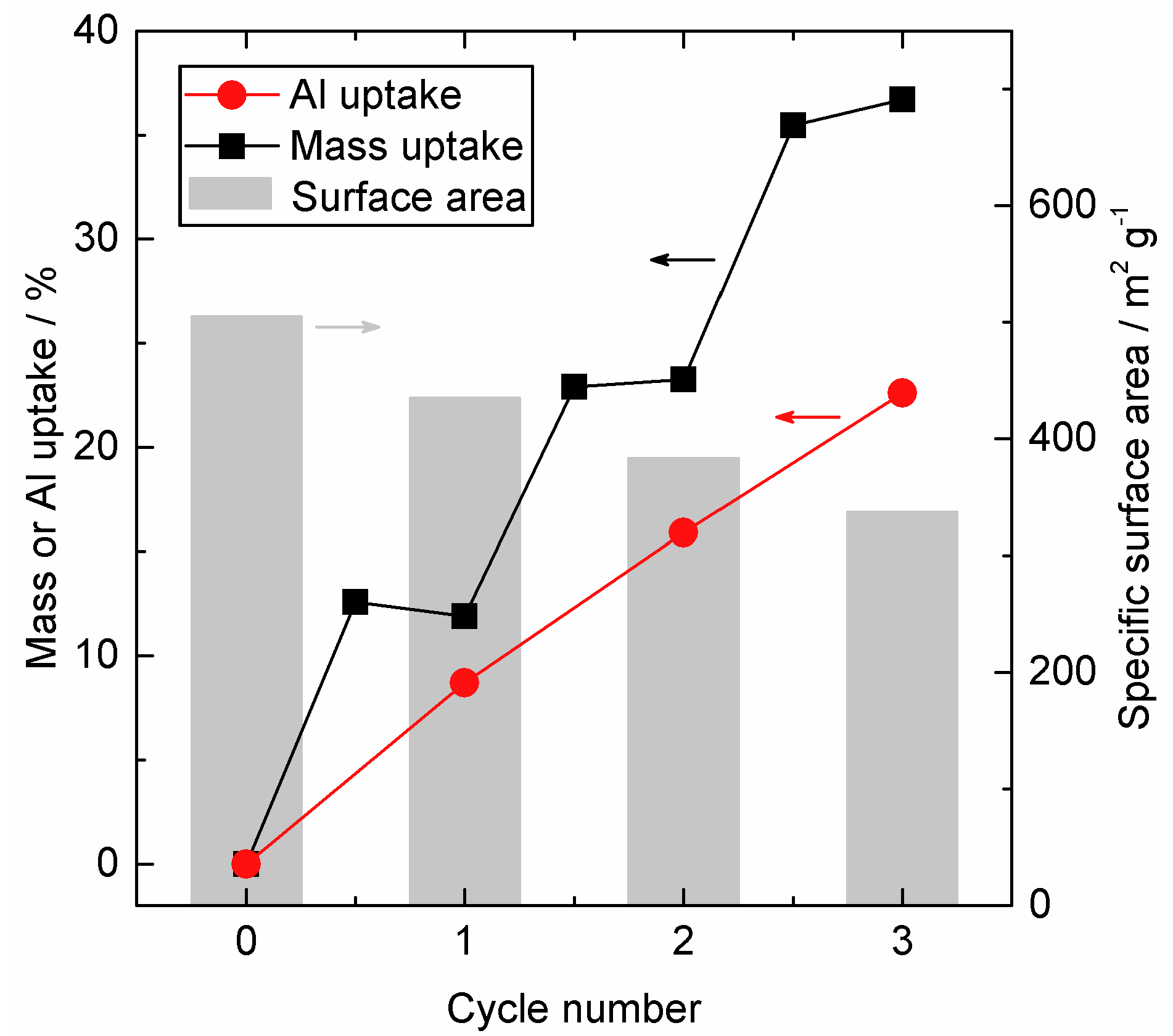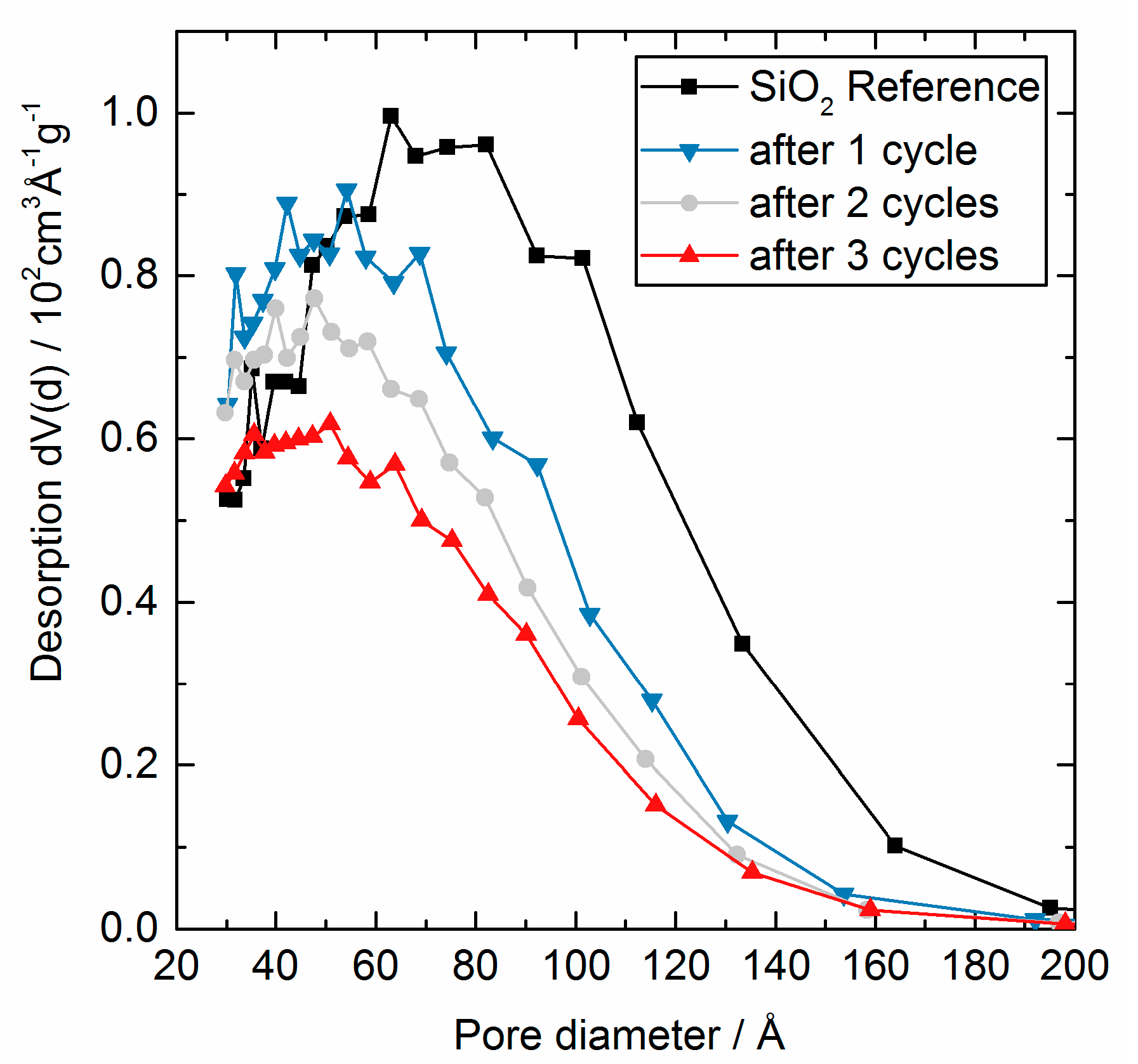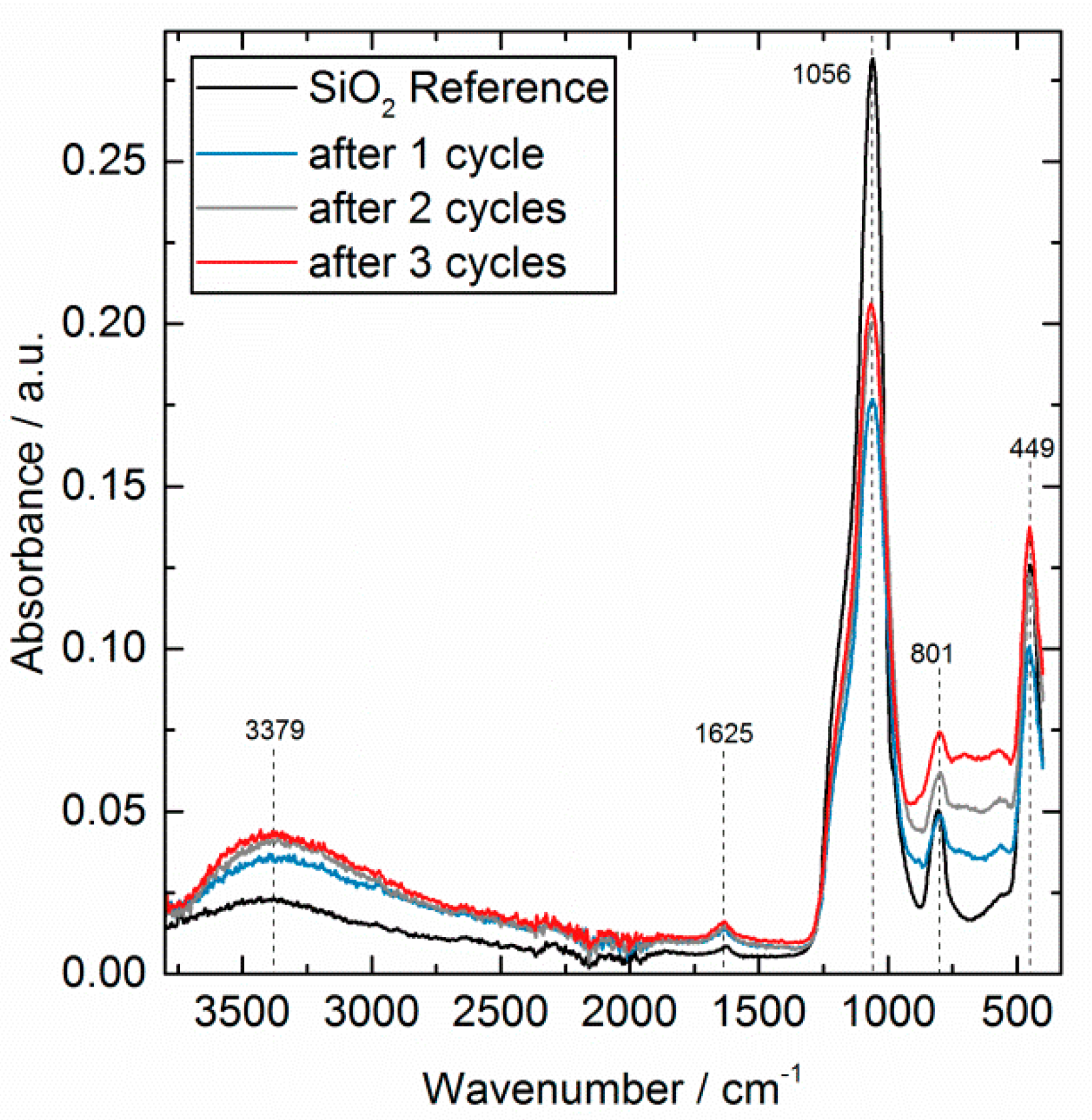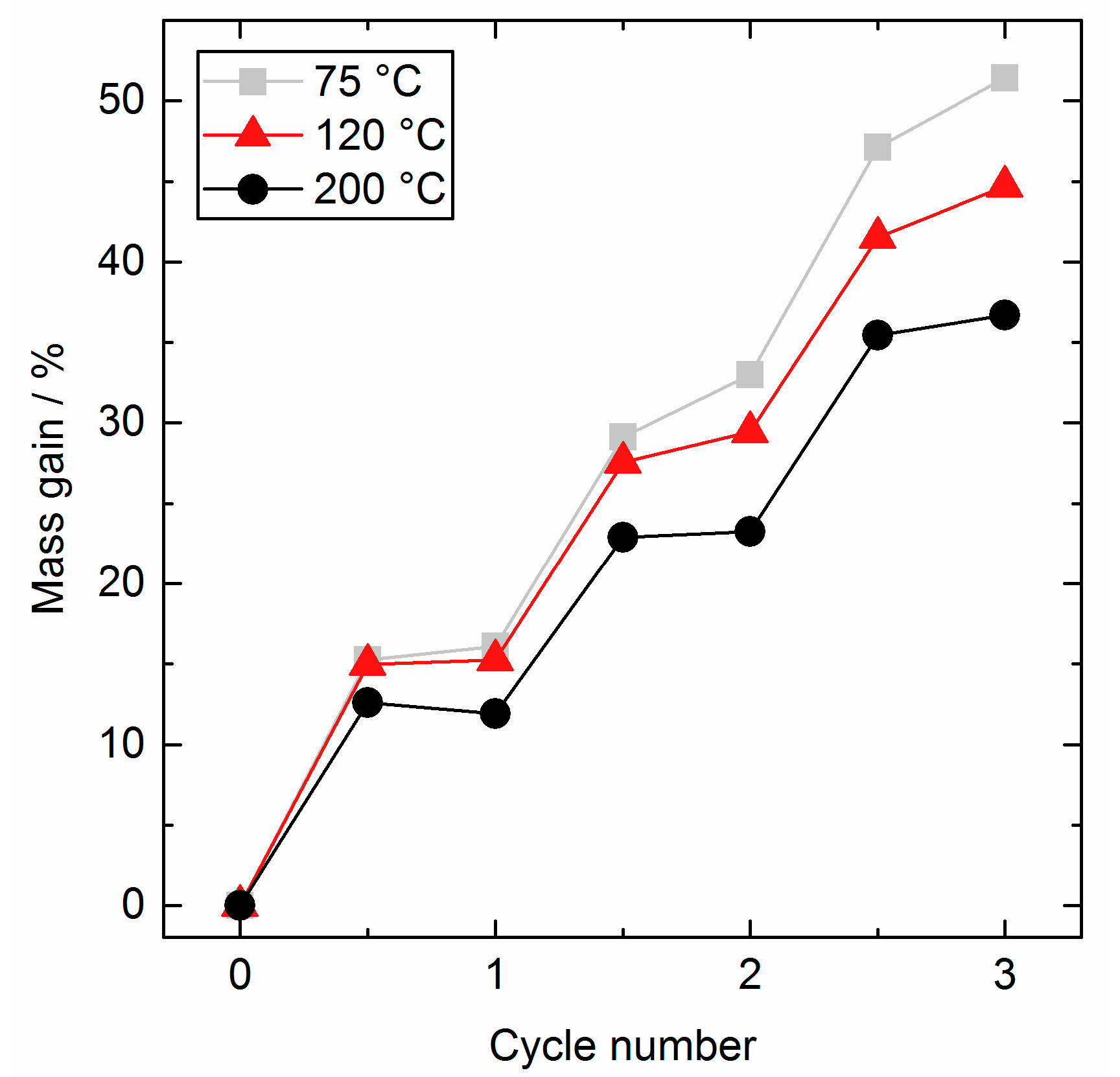Investigating the Trimethylaluminium/Water ALD Process on Mesoporous Silica by In Situ Gravimetric Monitoring
Abstract
:1. Introduction
2. Experimental Section
2.1. Chemicals
2.2. AlOx ALD Experimental
2.3. Characterization Methods
3. Results and Discussion
3.1. Influence of Cycle Number
3.2. Influence of Substrate Temperature
3.3. Scale Up in Fixed Bed
4. Conclusions
Supplementary Materials
Author Contributions
Funding
Acknowledgments
Conflicts of Interest
References
- Zaera, F. Nanostructured materials for applications in heterogeneous catalysis. Chem. Soc. Rev. 2013, 42, 2746–2762. [Google Scholar] [CrossRef] [PubMed]
- Polarz, S.; Smarsly, B. Nanoporous Materials. J. Nanosci. Nanotechnol. 2002, 6, 581–612. [Google Scholar] [CrossRef]
- Detavernier, C.; Dendooven, J.; Pulinthanathu Sree, S.; Ludwig, K.F.; Martens, J.A. Tailoring nanoporous materials by atomic layer deposition. Chem. Soc. Rev. 2011, 40, 5242–5253. [Google Scholar] [CrossRef] [PubMed]
- Strempel, V.E.; Löffler, D.; Kröhnert, J.; Skorupska, K.; Johnson, B.; Naumann d’Alnoncourt, R.N.; Driess, M.; Rosowski, F. Enhancing of catalytic properties of vanadia via surface doping with phosphorus using atomic layer deposition. J. Vac. Sci. Technol. A Vac. Surf. Films 2016, 34, 01A135. [Google Scholar] [CrossRef]
- George, S.M.; Ott, A.W.; Klaus, J.W. Surface Chemistry for Atomic Layer Growth. J. Phys. Chem. 1996, 100, 13121–13131. [Google Scholar] [CrossRef]
- Pemble, M.; Povey, I.; Chalvet, F. Developments in the Understanding of ALD Processes and Applications of ALD in Critical Technologies. ECS Trans. 2007, 11, 155–166. [Google Scholar] [CrossRef]
- Miikkulainen, V.; Leskelä, M.; Ritala, M.; Puurunen, R.L. Crystallinity of inorganic films grown by atomic layer deposition. J. Appl. Phys. 2013, 113, 2. [Google Scholar] [CrossRef]
- Haukka, S.; Lakomaa, E.-L.; Suntola, T. Surface coverage of ALE precursors on oxides. Appl. Surf. Sci. 1994, 82, 548–552. [Google Scholar] [CrossRef]
- Zaera, F. Mechanisms of surface reactions in thin solid film chemical deposition processes. Coord. Chem. Rev. 2013, 257, 3177–3191. [Google Scholar] [CrossRef]
- van Ommen, J.R.; Valverde, J.M.; Pfeffer, R. Fluidization of nanopowders. J. Nanopart. Res. Interdiscip. Forum Nanoscale Sci. Technol. 2012, 14, 737. [Google Scholar] [CrossRef]
- Haukka, S.; Kytökivi, A.; Lakomaa, E.-L.; Lehtovirta, U.; Lindblad, M.; Lujala, V.; Suntola, T. The utilization of saturated gas-solid reactions in the preparation of heterogeneous catalysts. Stud. Surf. Sci. Catal. 1995, 91, 957–966. [Google Scholar] [CrossRef]
- Puurunen, R.L. Growth per Cycle in Atomic Layer Deposition. Chem. Vap. Depos. 2003, 9, 327–332. [Google Scholar] [CrossRef]
- Puurunen, R.L. Surface chemistry of atomic layer deposition: A case study for the trimethylaluminum/water process. J. Appl. Phys. 2005, 97, 9. [Google Scholar] [CrossRef]
- O’Neill, B.J.; Jackson, D.H.K.; Lee, J.; Canlas, C.; Stair, P.C.; Marshall, C.L.; Elam, J.W.; Kuech, T.F.; Dumesic, J.A.; Huber, G.W. Catalyst Design with Atomic Layer Deposition. ACS Catal. 2015, 5, 1804–1825. [Google Scholar] [CrossRef]
- Strempel, V.E.; Naumann d’Alnoncourt, R.; Driess, M.; Rosowski, F. Atomic layer deposition on porous powders with in situ gravimetric monitoring in a modular fixed bed reactor setup. Rev. Sci. Instrum. 2017, 88, 074102. [Google Scholar] [CrossRef] [PubMed]
- Camacho-Bunquin, J.; Shou, H.; Aich, P.; Beaulieu, D.R.; Klotzsch, H.; Bachman, S.; Marshall, C.L.; Hock, A.; Stair, P. Catalyst synthesis and evaluation using an integrated atomic layer deposition synthesis-catalysis testing tool. Rev. Sci. Instrum. 2015, 86, 084103. [Google Scholar] [CrossRef] [PubMed]
- Sneh, O.; Clark-Phelps, R.B.; Londergan, A.R.; Winkler, J.; Seidel, T.E. Thin film atomic layer deposition equipment for semiconductor processing. Thin Solid Films 2002, 402, 248–261. [Google Scholar] [CrossRef]
- Rahtu, A.; Alaranta, T.; Ritala, M. In Situ Quartz Crystal Microbalance and Quadrupole Mass Spectrometry Studies of Atomic Layer Deposition of Aluminum Oxide from Trimethylaluminum and Water. Langmuir 2001, 17, 6506–6509. [Google Scholar] [CrossRef]
- Jakschik, S.; Schroeder, U.; Hecht, T.; Gutsche, M.; Seidl, H.; Bartha, J.W. Crystallization behavior of thin ALD-Al2O3 films. Thin Solid Films 2003, 425, 216–220. [Google Scholar] [CrossRef]
- Barrett, E.P.; Joyner, L.G.; Halenda, P.P. The Determination of Pore Volume and Area Distributions in Porous Substances. I. Computations from Nitrogen Isotherms. J. Am. Chem. Soc. 1951, 73, 373–380. [Google Scholar] [CrossRef]
- Mahurin, S.; Bao, L.; Yan, W.; Liang, C.; Dai, S. Atomic layer deposition of TiO2 on mesoporous silica. J. Non-Cryst. Solid 2006, 352, 3280–3284. [Google Scholar] [CrossRef]
- Dendooven, J.; Goris, B.; Devloo-Casier, K.; Levrau, E.; Biermans, E.; Baklanov, M.R.; Ludwig, K.F.; van der Voort, P.; Bals, S.; Detavernier, C. Tuning the Pore Size of Ink-Bottle Mesopores by Atomic Layer Deposition. Chem. Mater. 2012, 24, 1992–1994. [Google Scholar] [CrossRef]
- Dillon, A.C.; Ott, A.W.; Way, J.D.; George, S.M. Surface chemistry of Al2O3 deposition using Al(CH3)3 and H2O in a binary reaction sequence. Surf. Sci. 1995, 322, 230–242. [Google Scholar] [CrossRef]
- Katamreddy, R.; Inman, R.; Jursich, G.; Soulet, A.; Nicholls, A.; Takoudis, C. Post deposition annealing of aluminum oxide deposited by atomic layer deposition using tris(diethylamino)aluminum and water vapor on Si(100). Thin Solid Films 2007, 515, 6931–6937. [Google Scholar] [CrossRef]
- Catauro, M.; Bollino, F.; Cattaneo, A.S.; Mustarelli, P. Al2O3 2SiO2 powders synthesized via sol-gel as pure raw material in geopolymer preparation. J. Am. Ceram. Soc. 2017, 100, 1919–1927. [Google Scholar] [CrossRef]
- Jakschik, S.; Schroeder, U.; Hecht, T.; Krueger, D.; Dollinger, G.; Bergmaier, A.; Luhmann, C.; Bartha, J.W. Physical characterization of thin ALD-Al2O3 films. Appl. Surf. Sci. 2003, 211, 352–359. [Google Scholar] [CrossRef]
- Puurunen, R.L. Correlation between the growth-per-cycle and the surface hydroxyl group concentration in the atomic layer deposition of aluminum oxide from trimethylaluminum and water. Appl. Surf. Sci. 2005, 245, 6–10. [Google Scholar] [CrossRef]
- Groner, M.D.; Fabreguette, F.H.; Elam, J.W.; George, S.M. Low-Temperature Al2O3 Atomic Layer Deposition. Chem. Mater. 2004, 16, 639–645. [Google Scholar] [CrossRef]
- Ylilammi, M. Monolayer thickness in atomic layer deposition. Thin Solid Films 1996, 279, 124–130. [Google Scholar] [CrossRef]
- Grigoras, K.; Sainiemi, L.; Tiilikainen, J.; Säynätjoki, A.; Airaksinen, V.-M.; Franssila, S. Application of ultra-thin aluminum oxide etch mask made by atomic layer deposition technique. Monolayer thickness in atomic layer deposition. J. Phys. Conf. Ser. 561 2007, 61, 369. [Google Scholar] [CrossRef]
- Newnham, R.E.; de Haan, Y.M. Refinement of the α-A2O3, Ti2O3, V2O3 and Cr2O3 structures. Z. Kristallogr. 1962, 117, 235–237. [Google Scholar] [CrossRef]
- Pezzotti, G.; Zhu, W. Resolving stress tensor components in space from polarized Raman spectra. Phys. Chem. Chem. Phys. PCCP 2015, 17, 2608–2627. [Google Scholar] [CrossRef] [PubMed]
- Ott, A.W.; Klaus, J.W.; Johnson, J.M.; George, S.M.; McCarley, K.C.; Way, J.D. Modification of Porous Alumina Membranes Using Al2O3 Atomic Layer Controlled Deposition. Chem. Mater. 1997, 9, 707–714. [Google Scholar] [CrossRef]








| Description | Number of Cycles | Reactor Temperature/°C | Mass Uptake + − Cycle 1/% | Mass Uptake + − Cycle 2/% | Mass Uptake + − Cycle 3/% | Mass Uptake + − Total/% | Specific Surface Area/m2 g−1 | Al Content/wt % | Al Uptake +/wt % | C Content/wt % | C Uptake +/wt % |
|---|---|---|---|---|---|---|---|---|---|---|---|
| SiO2 reference | - | - | - | - | - | - | 506 | 0.0 | 0.0 | 0.00 | 0.00 |
| 200.1c | 1 | 200 | 12.5 | - | - | 12.5 | 435 | 8.0 | 8.7 | 1.52 | 1.55 |
| 200.2c | 2 | 200 | 13.4 | 11.6 | - | 24.0 | 383 | 13.7 | 15.9 | 1.59 | 1.62 |
| 200.3c | 3 | 200 | 11.9 | 11.4 | 13.4 | 36.6 | 337 | 18.4 | 22.6 | 1.33 | 1.35 |
| 120.3c | 3 | 120 | 15.2 | 14.2 | 15.2 | 44.6 | 263 | 17.8 | 21.6 | 2.43 | 2.50 |
| 75.3c | 3 | 75 | 16.1 | 16.9 | 18.4 | 51.4 | 248 | 17.6 | 21.3 | 2.66 | 2.74 |
| Description | Specific Surface Area m2 g−1 | Al Content wt % | C Content wt % |
|---|---|---|---|
| 200.3c | 337 | 18.4 | 1.33 |
| FB.top | 311 | 16.8 | 0.02 |
| FB.middle | 311 | 17.2 | 0.00 |
| FB.bottom | 305 | 15.8 | 0.00 |
© 2018 by the authors. Licensee MDPI, Basel, Switzerland. This article is an open access article distributed under the terms and conditions of the Creative Commons Attribution (CC BY) license (http://creativecommons.org/licenses/by/4.0/).
Share and Cite
Strempel, V.E.; Knemeyer, K.; Naumann d’Alnoncourt, R.; Driess, M.; Rosowski, F. Investigating the Trimethylaluminium/Water ALD Process on Mesoporous Silica by In Situ Gravimetric Monitoring. Nanomaterials 2018, 8, 365. https://doi.org/10.3390/nano8060365
Strempel VE, Knemeyer K, Naumann d’Alnoncourt R, Driess M, Rosowski F. Investigating the Trimethylaluminium/Water ALD Process on Mesoporous Silica by In Situ Gravimetric Monitoring. Nanomaterials. 2018; 8(6):365. https://doi.org/10.3390/nano8060365
Chicago/Turabian StyleStrempel, Verena E., Kristian Knemeyer, Raoul Naumann d’Alnoncourt, Matthias Driess, and Frank Rosowski. 2018. "Investigating the Trimethylaluminium/Water ALD Process on Mesoporous Silica by In Situ Gravimetric Monitoring" Nanomaterials 8, no. 6: 365. https://doi.org/10.3390/nano8060365





